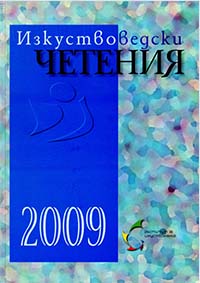Бележки по характера на българските паметници в периода между двете световни войни
Notes on the Character of Bulgarian Monuments in the Period between the Two World Wars
Author(s): Nikolay BoshevSubject(s): Theatre, Dance, Performing Arts
Published by: Институт за изследване на изкуствата, Българска академия на науките
Summary/Abstract: Each monument represents a unique document of the historical time it was made in. It offers compressed information about specific social phenomena or a concrete historical event or personality that had influenced on the life of the compatriots or humanity in general. Each monument bears data of its time, since it uncovers important moments of the way of thinking of a given society and along with this it bears witness of a certain stage of its development. The characteristic traits of a monument are consequence of the specific traits of the time it was created and 'lived', of its purpose and message that it has to deliver to its addressees. It is part of the spirituality of a nation, part of the environment that influences this spirituality. The observations on the characteristics of the monuments - military and civilian - in Bulgaria between the two world wars showed that there are interesting positive and negative traits. An important moment in monumental sculpture is its ambition to show the national character and to achieve original national characteristics. In the final formation of the image of the monument an important role undoubtedly is played by its ambition to comply with the European artistic experience in this direction. During the period, covered by the research, Bulgaria was dominated by the neo-classical approach in the treatment of plastic forms. 'Arming' one with such a model is not a coincidence. It is a direct consequence of the West European approach, adopted in the construction of monuments. It seems that neo-classicism is the most appropriate style for the creation of heroic images whose function is to have impact on the viewer without challenging his ability to perceive a given type of visual images. The accent on the didactic function of the monument that has to be perceived without any difficulties by different social groups leads to the creation of a stereotype image. The hero is shaped as a stable iconographic type which is especially noticeable when observing military monuments in the villages and the small Bulgarian towns. Each element of the monument is semantically treated - be it an image, inscription, plastic sign, relief story - and the place of each component is strictly defined while at the same time a hierarchic arrangement and use is realized. The more direct impact that is being sought on the thoughts and emotions of the mass audience quite often lead to simplicity, elementary impact and in general to the elementary perception of the monument that cannot be really important because it lacks an associative impact and power of suggestion. The Bulgarian monuments of the 1920 and 1930 seek the concreteness of the image in order to reinforce the reality of the event in the mind of the perceiver.
Journal: Изкуствоведски четения
- Issue Year: 2009
- Issue No: 5
- Page Range: 219-225
- Page Count: 7
- Language: Bulgarian
- Content File-PDF

